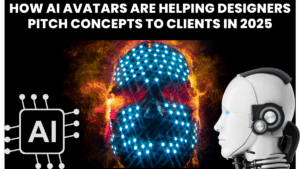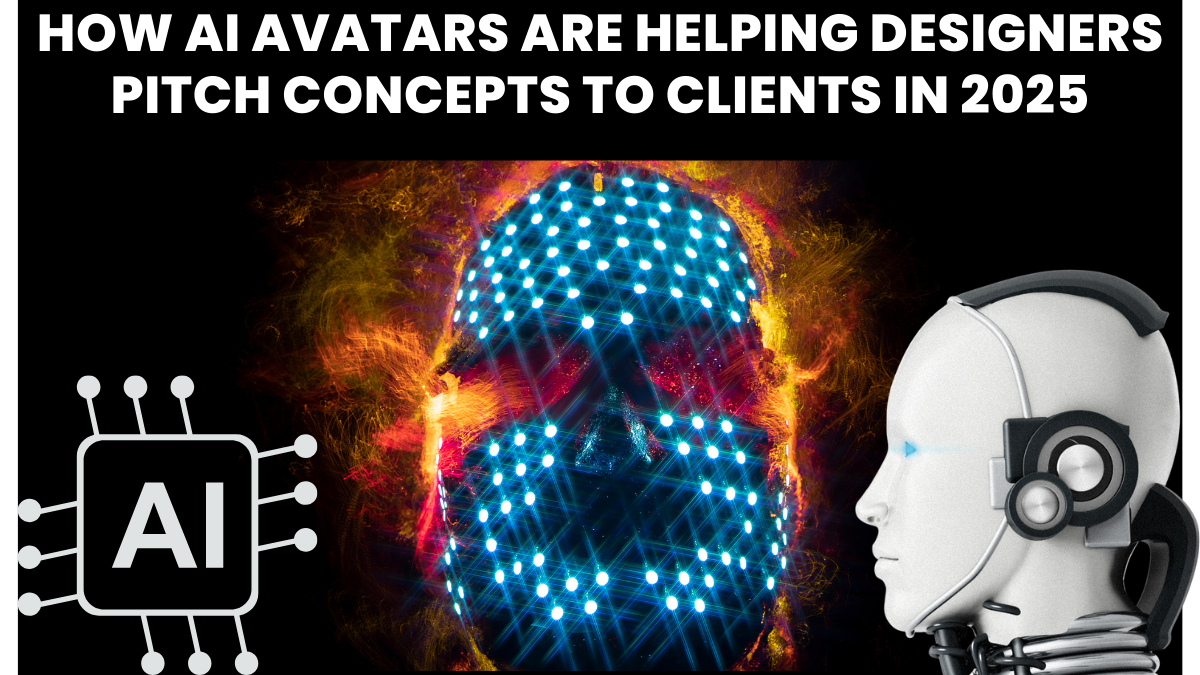In 2025, designers no longer rely only on static slides or flat mockups when presenting ideas to clients. Thanks to advances in AI avatars for designers 2025, pitches are now more interactive, engaging, and persuasive than ever. These digital avatars, powered by advanced design concept pitch AI, simulate real human interaction, explain creative concepts, and even adapt to client responses in real time.
This shift has transformed the design industry. From architecture and fashion to branding and product design, AI avatars have become trusted partners in bridging the gap between vision and communication. Instead of long explanations, designers can now show clients a lifelike AI avatar that narrates, demonstrates, and visualizes the concept with clarity.

What Are AI Avatars in Design?
AI avatars are virtual humans created using artificial intelligence and 3D modeling. In design presentations, they act as spokespeople who present project ideas, explain concepts, and interact with clients. Unlike simple voiceovers or animations, these avatars have realistic expressions, gestures, and voices that make the pitch feel more personal and professional.
For example, a fashion designer can use an avatar to model outfits in real time, while an interior designer might showcase how a living room design will look with different lighting options—all narrated by the AI avatar.
Why Designers Are Using AI Avatars in 2025
The rise of design concept pitch AI is fueled by several benefits:
-
Better Engagement: Clients pay more attention when pitches are interactive and dynamic.
-
Clearer Communication: Complex ideas are easier to understand when explained visually.
-
Time Savings: Avatars handle repetitive parts of presentations, letting designers focus on creativity.
-
Global Reach: Avatars can speak multiple languages, helping designers pitch to international clients.
-
Personalization: AI avatars can be styled to reflect the designer’s brand or even resemble the designer themselves.
These advantages make AI avatars a natural fit for today’s fast-paced, client-driven design world.
Popular Tools for AI Avatars in 2025
A range of platforms are making it easier for designers to integrate avatars into their workflow. Leading tools include:
-
Synthesia AI: Known for creating lifelike avatars that narrate presentations in multiple languages.
-
HeyGen: Offers customizable avatars with professional voices for pitches and explainer videos.
-
Reallusion Character Creator: Allows full 3D modeling of avatars for product design and animation.
-
D-ID AI: Specializes in talking avatars created from photos, ideal for quick design pitches.
-
Fable Studio AI: Focused on storytelling avatars that engage audiences with emotional expressions.
These tools allow designers to move beyond traditional PowerPoint presentations and bring ideas to life.
How AI Avatars Enhance Concept Pitches
Designers are finding creative ways to use avatars during presentations:
-
Fashion Design: Avatars act as virtual models, showcasing how garments fit and move.
-
Interior Design: Avatars walk clients through a digital home, pointing out furniture placements and design choices.
-
Architecture: Avatars present 3D walkthroughs of buildings, making technical details easier to grasp.
-
Branding: Avatars introduce logos, packaging, and brand identity with engaging narratives.
-
Product Design: Avatars explain functionality, usability, and customer benefits in simple terms.
By making pitches more interactive, avatars help designers win client trust faster.
Benefits for Clients
From the client’s perspective, AI avatars make the design process far more accessible. Instead of deciphering technical terms, clients get a clear, visual explanation. Some of the main benefits include:
-
Immediate Understanding: Clients see concepts in action, not just in sketches.
-
Interactive Choices: Avatars can show variations—colors, layouts, or materials—on the spot.
-
Confidence in Decisions: Seeing a lifelike presentation reduces doubts and increases satisfaction.
-
Time Efficiency: Shorter meetings with more clarity save clients valuable time.
This client-centric approach is why AI avatars are being quickly adopted across industries.
Challenges of Using AI Avatars
Despite their advantages, AI avatars do present challenges:
-
Cost: Premium avatar platforms may be expensive for freelance designers.
-
Learning Curve: Designers need to learn how to integrate avatars seamlessly.
-
Authenticity: Some clients may prefer direct interaction with the designer over a digital avatar.
-
Technical Dependence: Avatars require strong internet and hardware support for smooth operation.
Still, with practice and thoughtful integration, these challenges can be minimized.
Future of AI Avatars in Design
Looking ahead, AI avatars are expected to become even more sophisticated. Avatars may soon be able to read client emotions through facial recognition and adjust their tone or presentation style accordingly. Integration with AR and VR will also allow clients to interact with avatars in immersive environments, creating an even deeper experience.
For India, this trend is particularly promising. With startups, interior designers, and branding agencies growing rapidly, adopting AI avatars for designers 2025 ensures competitiveness in both domestic and international markets.
Final Thoughts
The introduction of design concept pitch AI marks a turning point in how designers communicate their vision. In 2025, AI avatars are not just presentation tools but strategic partners that help bridge creativity and client understanding. They reduce misunderstandings, accelerate approvals, and add a professional edge to pitches.
For designers, adopting avatars is no longer optional—it’s a step toward staying relevant in an industry where innovation and communication matter most.
FAQs
What are AI avatars in design pitches?
They are virtual humans powered by AI that present design concepts interactively to clients.
How do AI avatars help designers?
They improve engagement, clarify complex ideas, and save time by handling repetitive explanations.
Are AI avatars expensive to use?
Costs vary, but many platforms now offer affordable subscriptions for freelancers and agencies.
Will AI avatars replace designers in client meetings?
No, they act as assistants to enhance presentations, but designers remain central to creativity and decision-making.
Click here to know more.
